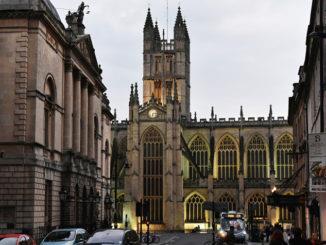
A local haulier has warned Bath and North East Somerset (B&NES) council that its decison to launch a clean air zone (CAZ) in the city will significantly lengthen HGV journey times as drivers seek out alternative routes to avoid being charged.
The scheme is due to launch next March and imposes charges on vehicles that do not comply with Euro-6 diesel and Euro-4 petrol emissions limits. A charge of £9 per day will be applied to non-compliant “taxis, private hire vehicles, minibuses, LGVs and vans (including pick-ups and campervans)”, while a £100 per day charge will be levied on “buses, coaches and HGVs”.
However, Robert Wilcox, MD of haulage company Massey Wilcox, based near Bath believes that heavy traffic that would normally travel towards Bath to pick up the A36 towards Salisbury and A367 Bath to Wells roads will now use the roads of West Wiltshire, a few miles to the east of Bath.
He gave the example of the B3105 which will serve as a link road for vehicles routeing around the Bath CAZ: “This minor road has to now handle heavy traffic from the bottom of the A46/A4 junction back towards Trowbridge from where we then have to travel a very convoluted route to get back to our depot in Chilcompton," he said. "This makes what was a 15 mile journey into a 38 mile journey. So 23 additional miles worth of diesel, the pollution of which produced spread nicely over Wiltshire. To say nothing of the cost in time and fuel to my company.”
The RHA also rejected Bath's decision to impose a clean air zone. DfT statistics on NOx emissions show that cars and taxis continue to be a far greater source of nitrogen oxides than HGVs. Emissions for both have continued to fall from 2000 onwards with Euro-6 emissions accelerating the trend. The RHA’s NOx Emission Assessment published in August shows that from a 2013 baseline, NOx emissions fell by 59% to the end of 2019.
“It’s a consistent improvement of emissions standards over time that has seen the drop in emissions. It’s not the deterrent effect of charging vehicles to stay out of an area," said Chris Ashley, head of policy - environment and regulation at the RHA.
Read more
- Bath and Birmingham press on with clean air zone plans
- Hauliers face £100 Bath Clean Air Zone charge ‘stealth tax’
- Bath Clean Air Zone faces delay after ‘unprecedented’ response to proposals
Bath does not have a bypass and traffic travelling north from the Southampton and Salisbury directions via the A36 has few options but to pass through the city. Earlier public consultations on the CAZ drew significant local opposition for private car charging and the plan was withdrawn in favour of the current scheme.
MT asked B&NES Council how many vehicles a day are likely to be charged under the new scheme. The response suggests that the number of non-compliant vehicle trips in the first 12 months of operation could be 213,000: “It is not possible to give a daily estimate as this is expected to change substantially over time,” a spokesman said.
This may be because the number of non-compliant vehicles are expected to have been reduced considerably by the time the scheme starts because of ongoing vehicle replacement programmes.
This point was made in a report prepared by consulting engineers Jacobs on the likely diversion impact on roads to the east of Bath in October 2018, marked for the attention of B&NES Council. Jacobs was prepared to estimate the number of vehicles affected daily, suggesting that an upper limit of non-compliant trips would be 565 on a typical weekday, 65 of these being HGVs.
The Jacobs report expects that only a small proportion will avoid the zone and suggests, “the vast majority of the country’s HGV fleet is expected to be compliant as a result of the implementation of CAZs in a number of cities.”
Experts said that although that may have been the expectation in 2018, it is certainly not the case now.














